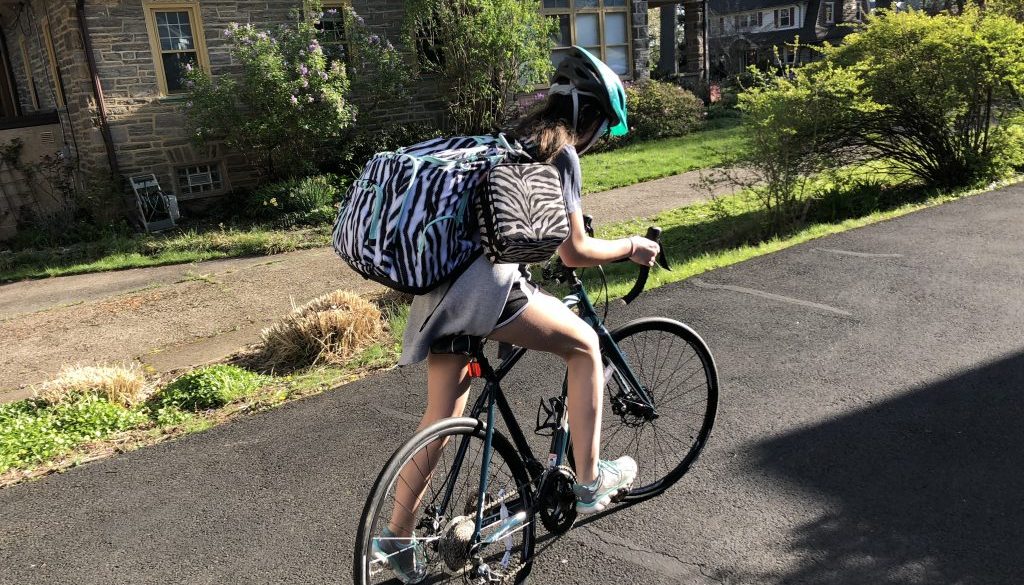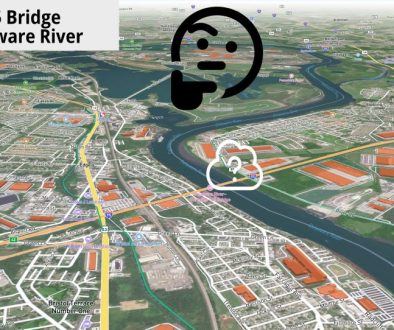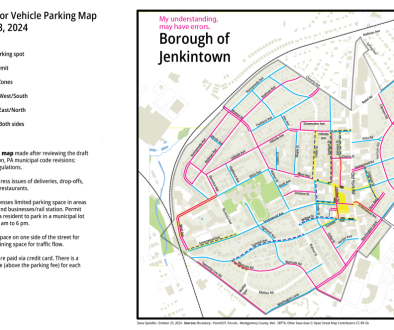Montco PA’s bike plan – my thoughts
Bike plans make a difference
I teach cartography at Temple University. Students bike several miles to get to class and I see professors riding electric bikes. There are ample bike racks outside Gladfelter Hall filled with lots of bikes. When I was in grad school in the early 1990’s, we had two tiny bike racks, and I had memorized the poles that I could lock to.
Bikes are viable and fun as a way to get around. And I believe that electric bikes have potential in Montgomery County (like in Germany), where there are hills. I’ll write about that another time. In 2000 I was at Velo Mondial, an international bike conference in Amsterdam. I got to drive/pedal an enclosed velomobile. This is the future, I thought.
Because hills and the traffic are barriers to cycling, a combination of new electric assist bikes (for going uphill effortlessly) and dedicated bike facilities, will make getting around without a car more feasible in next few years. An age of technology and invention combined with a decent road infrastructure makes this possible.
What problem is the county bike plan solving?
Like most suburban US counties, cars are the dominant transportation mode in Montgomery County, PA. Bicycling on roads is not perceived as safe. Even if you live within a mile or two of shopping, parks, schools, and jobs, you’re more likely to drive.
How does the plan address the problem?
The plan proposes a bicycle network of on-street bicycle facilities to complement the county’s expanding county trail system. This would expand on-road facilities in the county from about .05% to 17%.
Here’s a map around Jenkintown. Email me if you want to look over the whole county network map.
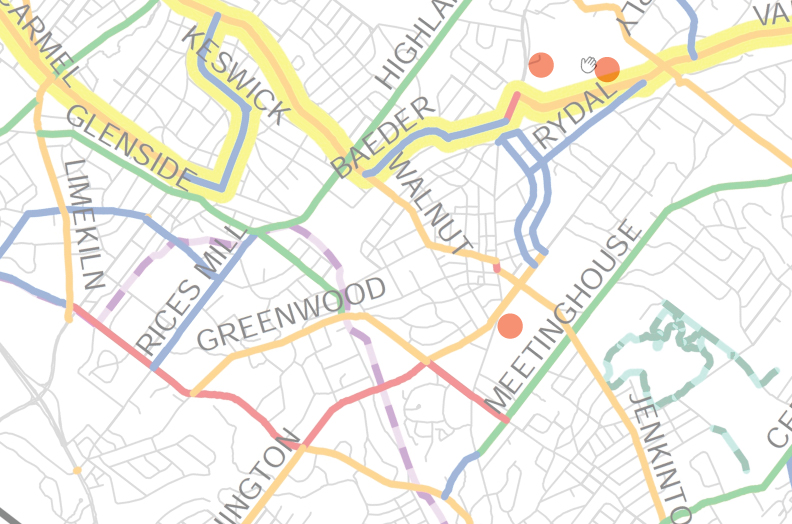
How are roads assessed?
The county used Level of Traffic Stress Analysis to identify islands of bikeable streets that can be connected and expanded. The county contracted DVRPC to do this, and this analysis was ultimately done for all of the suburban counties.
Survey Monkey was used to collect perspectives. And my website, wikimapping.com, was used to get location-specific public input. To get a county-wide demographic to respond, the county made surveys available to people coming for jury duty.
How can the county’s plan be implemented?
A large committee (about 30 people?) of government, community, business and advocacy stakeholders has developed this plan. Collaboration with PennDOT, DVPRC, SEPTA, TMA’s, developers, municipalities and advocates is the only way such a plan can move forward. Through collaboration, the county can act on this plan. My sense is that bike projects will be incorporated into larger transportation projects when possible.
What’s in the plan?
- Background about the county
- Goals of the plan
- Data about the county
- Data about the cycling audience
- Process for collecting data specific to the plan
- Analysis of the data
- Proposed network
- Proposed policies
- Examples of implementation
The plan will be used by county staff and stakeholders
I share Kimberley Bezak’s (a Narberth parent) concern that some audiences will look at corridors in this plan and think, “This road is not on the plan, so the county doesn’t think it’s a priority.” PennDOT contractors may look at this like a guide. And I’ve seen how bicycle maps have been used by PennDOT contractors when justifying their plans. Even the county planning staff recognizes this.
Most people won’t read the plan. This is why planners have tried to create a visual, concise, county-focused plan with some practical applications.
Planners and stakeholders have gotten to know each other as they’ve developed the plan. While focusing on “The Plan,” all the people at the table have listened to one another.
County planners have demonstrated a high degree of competence and professionalism. I expect that they will use this plan to stay on top of communications with multiple stakeholders.
I believe that county planners, with continued feedback from committee members, will act as ongoing interpreters of the plan.
The plan creates a staff position to support implementation
To communicate with municipalities, PennDOT and other stakeholders, the plan calls for dedicated staff to show up and educate people about how the plan fits into the county’s goals.
When you say, “We are going to place bicycle facilities on 17% of the roads in the county,” this percentage creates a metric that the county can use to assess implementation.
But I think a lot more is going to happen than this. Because of the success of community bike rides like “Trader Joe’s Mondays,” started by Bezak in Narberth, consumer demand will cause businesses to better serve their cycling customers. Hopefully staff person at the county can teach businesses how to support cyclists too.
PennDOT has a bike plan in progress too
Here’s a link to PennDOT’s plan.
I just filled out PennDOT’s Bicycle Survey (and you can too). The questions were largely multiple choice, and I often found that I couldn’t relate to any of the answers. For both plans, I think PennDOT roads are the weak link. I hope this changes. For those of us who are “Smart, Fearless, and engaged,” we can still assume our right to use Old York Road, Lancaster Ave and Montgomery Ave.
Borough Connectivity has to improve
While it may be pleasant to bike within boroughs like Narberth, Ambler and Jenkintown, problems for cyclists occur just beyond their political boundaries. This is what I would like the county plan to specifically address along state roads such as Montgomery Avenue, Old York Road, Washington Lane. The plan currently documents that over 10% of respondents county-wide said that it is too difficult to ride on 611.
But 10 years from now, will conditions be much different? Will people feel safe bicycling? Actually, what if the county and Jenkintown were to create a pop-up bike lane on 611 for a week or two, kind of like Princeton did? People might like it. They might hate it. But they would have something temporary and tactile to respond to. And it might be useful in advance of the Noble bridge reconstruction. We could post a banner on Old York Road asking people to text their opinion of the new configuration.
Here’s where I think bike lanes would be good:
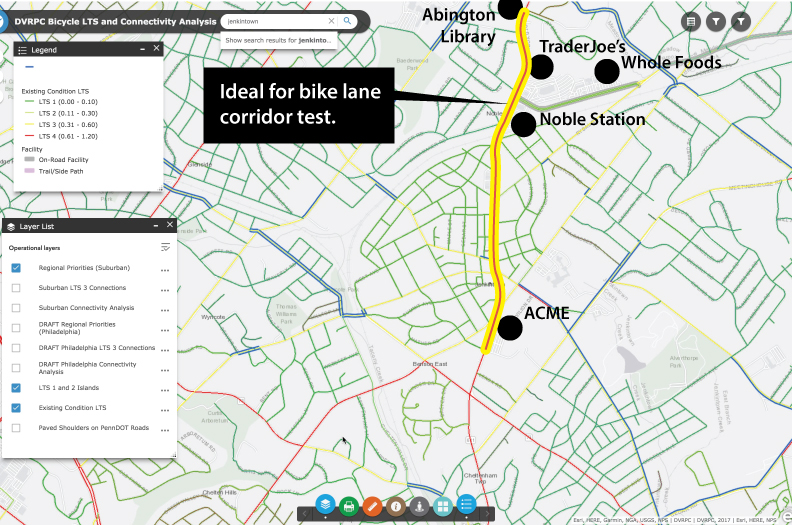
Will the plan lead to better bicycling conditions?
To this question of improving bicycling conditions, I think the answer is qualified “yes.” I think the plan will support a growing active lifestyle demographic in specific areas of the county or fearless riders everywhere. I don’t foresee my neighbors letting their kids bike on state roads surrounding Jenkintown until they feel it is safe.
By itself, I don’t think this plan will reduce (or is intended to reduce) the number of vehicles on the road. Over the last 40 years, bicycling conditions in the US haven’t improved that much in suburban counties like ours. Other factors may reduce motor vehicles though.
Staying involved is necessary but demands a lot of time
Showing up at meetings is costly. It’s a privilege to give up half a day every month or two to go to Norristown. A lot of the people that this plan serves can’t afford to do this. Oh, and it’s not just county meetings. If you want to be an advocate, you need to show up for daytime meetings at DVRPC, municipal council meetings and special events. Then there’s not shortage of plans and documents to review.
Here are actions we can take:
- Join the Bicycle Coalition, which has county specific committees and a facebook page
- Talk about bicycling with friends, and go on rides together
- Develop bike committees within municipalities
- Ride bikes for (at least some) utilitarian trips under two miles
- Learn about bike policy and the people implementing it
- Request bike racks at grocery stores (they’re cheap and can be branded like we did in Jenkintown)
The county is doing its part, but there’s no central authority that independently creates change. While the county takes action, municipalities have to as well. Municipalities can take steps to become certified by the League of American Bicyclists as “Bicycle Friendly.“
Finally, I want to express my gratitude
In May of 2015, Commissioner Josh Shapiro (now PA Attorney General) and the other County Commissioners got behind the idea of creating a county bicycle committee, coordinating Level of Traffic Stress to create a baseline to measure from, and developing a plan that would be inclusive of a broad selection of stakeholders. Valerie Arkoosh and Kenneth Lawrence, our current commissioners have continued to promote bicycling in the county (I don’t know if Commissioner Gale has).
It helps that another Montgomery County Commissioner, Leslie Richards, went on to lead PennDOT. And Leo Bagley, who headed up transportation in Montgomery County for so many years continues to work with Richards in Harrisburg.
Abington Township commissioners have set an example by developing a municipal bike plan. Montgomery County staff puts in a lot of irregular workweeks to make things happen.
So… Thank you everyone for investing time, money and energy into making Montgomery County better.
